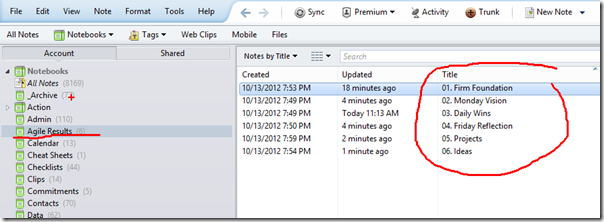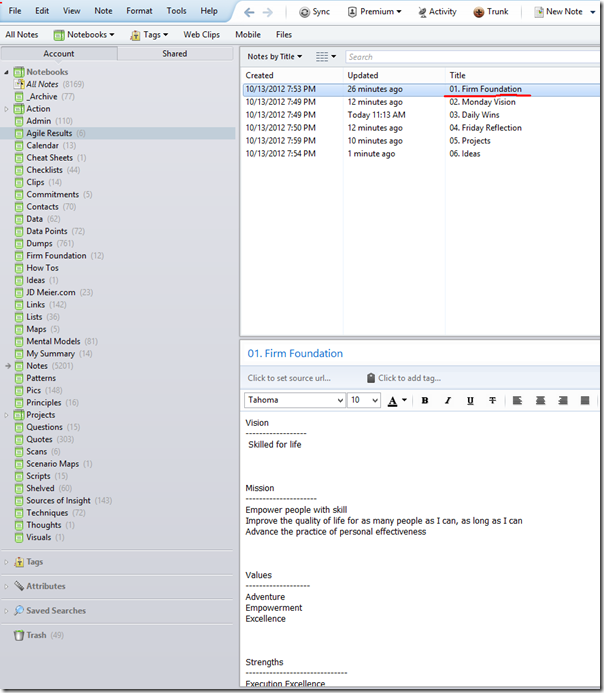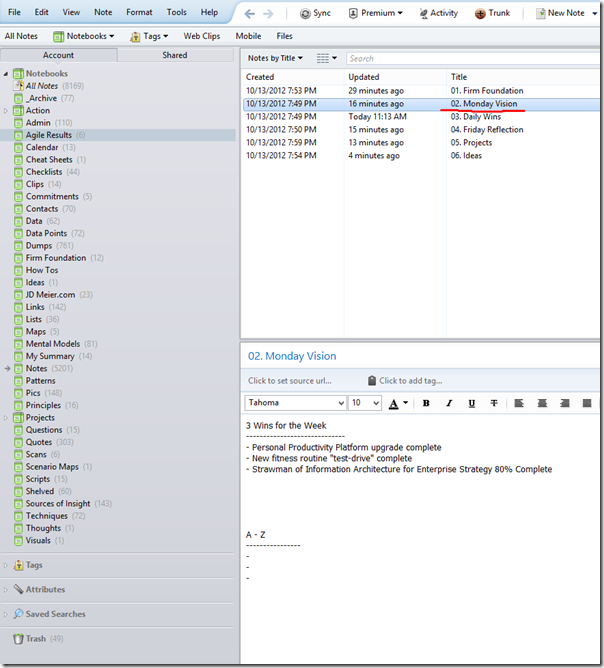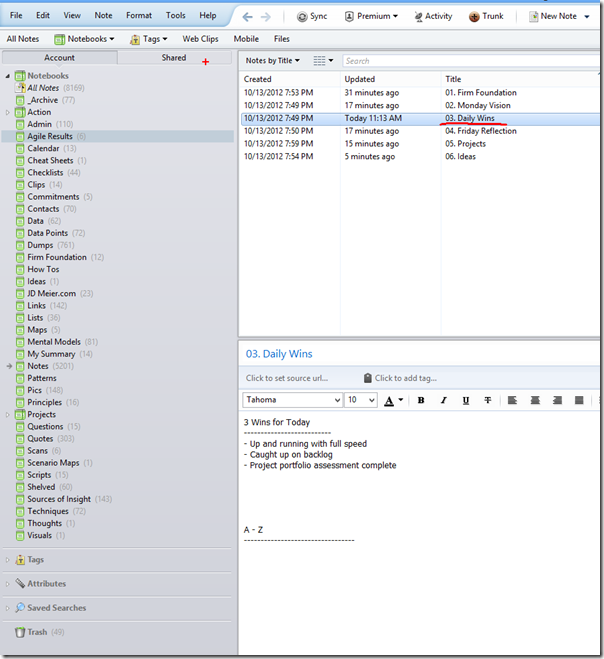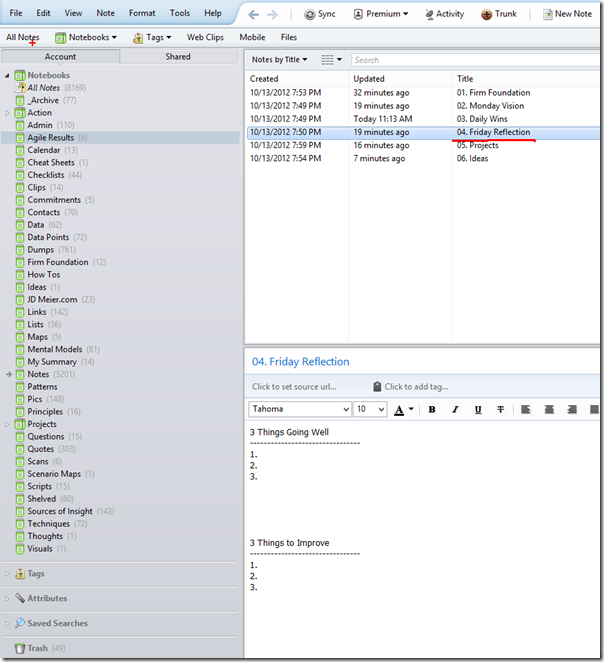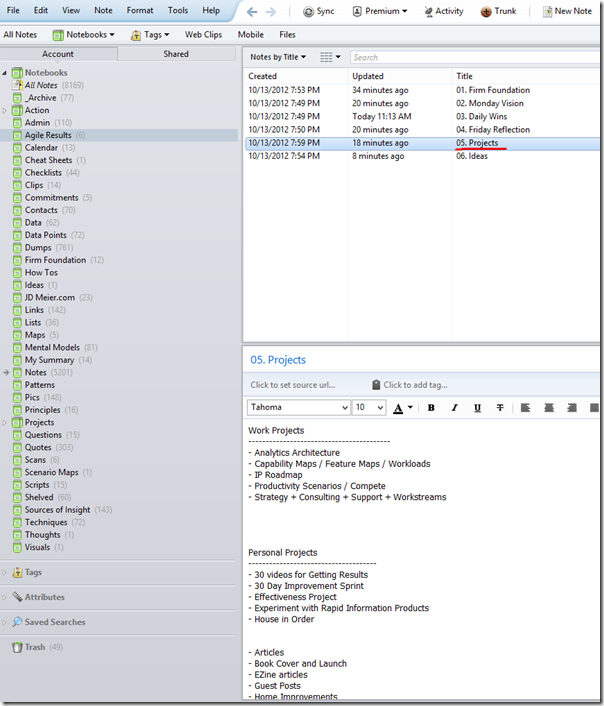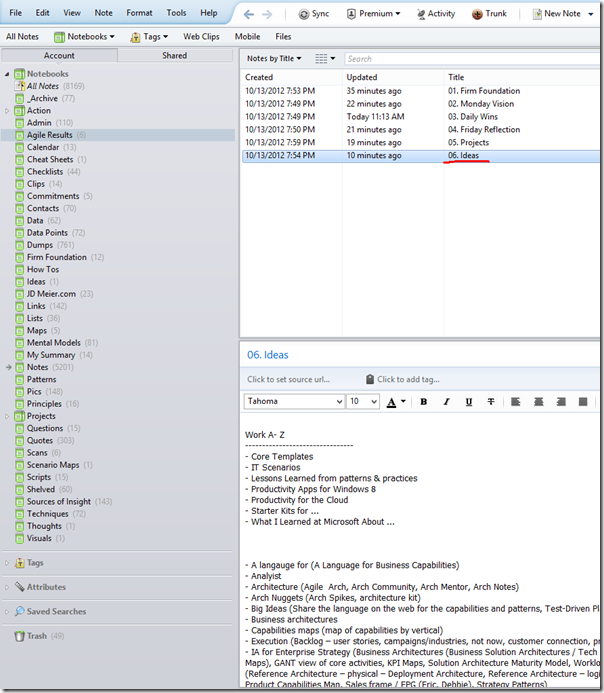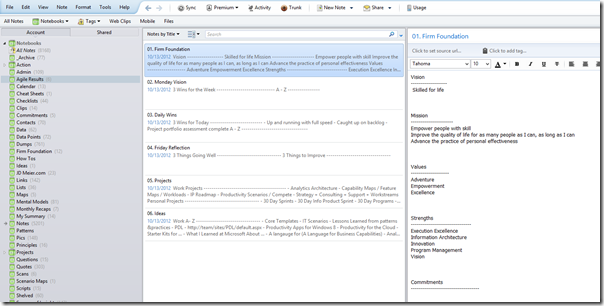Agile Results in Evernote with One Notebook
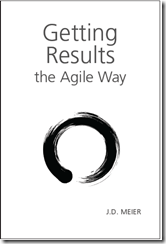 Agile Results helps you achieve “Agile for Life”, which means flow value, while you learn, and adapt to change.
Agile Results helps you achieve “Agile for Life”, which means flow value, while you learn, and adapt to change.
I’ve written about how to use Agile Results with Evernote before, but some of you wanted a simplified version. In this post, I’ll share an approach with you for using Agile Results with Evernote, using just one Notebook and six simple notes. With this approach, you’ll have all of your vision, mission, and values at a glance, your daily and weekly goals, your list of work and personal projects, and all your ideas at a glance.
And you can set it all up in under three minutes.
All of the information you need to master motivation, time management, and productivity will be at your fingertips, with one place to look.
I’ll also share some new insights that I’ve learned around dealing with lists to help you manage them more effectively. And I’ll also share some insights on how you can get a much better performance review, and compete in today’s world more effectively by focusing on higher-value things.
What is Agile Results
But first, let’s take a step back and recap what Agile Results is all about. Agile Results is a simple system for meaningful results. It helps you do less, but achieve more by combining proven practices for motivation, productivity, and time management. It works by helping you focus your time, energy, and skills, using a few key concepts. The big ideas are: 1) it’s outcomes, not activities, 2) it’s value, not volume, and 3) it’s energy, not time. (Tip – Value is the short-cut in life. If you know what’s valued, you can target your efforts. Here is another tip – Value is in the eye of the beholder.)
Agile Results helps you flow value to yourself and others, while responding to change, and taking the balcony view. It helps you thrive in change. It helps you learn new things. It helps you adapt to our ever-changing world, and come out on top. It helps you win, and it helps you go for the epic wins in life.
Agile Results is not just a personal productivity system. It works for teams, too (I’ve used it to lead high-performing, distributed teams around the world for more than ten years.) That said, if you want to use it as your personal time management system, it does help you get the edge. Part of the power is that it synthesizes many principles, patterns, and practices for high-performance, down into a small set of proven practices.
The simplicity of the system is important. It helps you spend more time doing, and less time planning. The simplicity also helps you adapt the system to you and to any situation. It also makes it easy to get started with Agile Results (you can use it right now, simply write down three wins that you want to achieve today.).
You can find out more about Agile Results (and everything you need to know about mastering personal productivity, motivation, and time management) in my book, Getting Results the Agile Way. It’s been an Amazon best seller for Time Management (it was #1 in Germany several time, and in the U.S. it’s been in the top 5, but floats around within the top 100.)
Now, let’s see how to use Agile Results with Evernote in a simple, but highly effective way …
Agile Results Notebook in Evernote
Here is a look at Agile Results in Evernote:
As you can see, it’s one Notebook called “Agile Results”, and it contains six Notes. The six notes are:
- Note #1 – Firm Foundation
- Note #2 – Monday Vision
- Note #3 – Daily Wins
- Note #4 – Friday Reflection
- Note #5 – Projects
- Note #6 – Ideas
I’ll walk through each Note below, but first I’ll summarize the big ideas behind the notes. The Firm Foundation is meant to give you a quick reminder of your vision, mission, and values at a glance, as well as your strengths. It’s a way to help you get “on path” and stay on path.
The Monday Vision, Daily Wins, and Friday Reflection will look familiar if you know Agile Results. This is the little weekly rhythm of results. The beauty is that this little combo helps you flow value on a daily and weekly basis, as well as continuously adapt and improve. On Monday, you identify the three wins you want to achieve for the week (notice that I said “win”, not “tasks.” A task might be “call a customer”, but the win would be “win a raving fan.” Rather than just doing tasks, you focus on value and making a difference. This is the secret to getting better performance reviews, flowing more value, moving up in the world, and getting off the treadmill of life.)
Daily Wins is where you list your three wins that you want to accomplish for the day, and then all of your tasks or top of mind things. While Monday Vision helped you set three priorities for the week, your Daily Wins helps you set three priorities for your day. By keeping these three priorities front and center, you define your success for the day. It also helps you focus and prioritize throughout the day. If you have to keep changing these, then you will start to notice whether you are trading up, or just getting randomized. You will also start to notice whether the tasks you do actually support meaningful goals. You will also get better at defining three wins for your day.
See the pattern so far? Identify three wins for the week and identify three wins for the day. By having two levels of wins, you can zoom out or zoom in. Your little wins will add up each day, and your wins for the week will help you stay on track. As you an imagine, by the end of the month, you have created significant momentum and impact. Oh, and by the way, you will rapidly improve your personal productivity along the way. How? … with Friday Reflection.
Friday Reflection is just like how it sounds. On Fridays, you reflect. You review your results. To do so, you simply ask yourself, “What are three things going well?”, and “What are three things to improve?” Both question are important. The one helps you identify your personal habits and practices that are working. The other helps you identify specific areas you can improve. For example, if you are not achieving your wins, are you biting off the right things? Are you biting off too much? Are you trading up for things or getting randomized? You will see patterns and opportunities for improvement. And the beauty is that you can take what you learn and apply it next week. And you get to practice each day. That’s the big idea in Agile Results … little wins with continuous improvement add up to big, bold changes in work and life.
The Projects Note is simply a list of your work projects and your personal projects. This is an important list. If you can’t name the things you are working on, then you really can’t prioritize. Worse, you can’t really focus. Even worse, you won’t be very effective at telling or selling your work to others, whether that is your manage or your team or more. When you have a list of what’s on your plate, you instantly have the bird’s-eye view. You can now see whether you are splitting your time across too many things, or whether too many unimportant things are getting in the way. As a sanity check, how would you rate the value on a scale of 1-10 of each of the items on your plate, where 10 is most awesome, and 1 is the pits? This can be a real wake up call. If all of the things on your plate are low-value items, your next win is to get high-value things on your plate, and squeeze out the low-value stuff, with more high-value stuff.
The Ideas Note is actually your Backlog, from an Agile Results perspective. I’ve found that more people tend to prefer thinking in terms of “ideas” than “backlog”, although, the reality is many people actually have a Backlog of ideas. That said, this is Agile Results, and it’s flexible, so whatever you want to call that works for you is fine. What’s important is getting the concept right. In the Ideas Note, you simply list your ideas for work, and your ideas for personal projects. By getting things out of your head and down on to “paper”, you can free up your mind to do better things, and you can better analyze your lists of ideas, when you can see it right in front of you, versus swirling around in your mind.
The big difference between the Ideas Note and the Projects Note is that the Projects Note is a list of your active projects. It’s stuff that’s really on your plate. The Ideas Note, on the other hand, is your list of things that are not yet active (That’s why I often refer to it as a Backlog.)
One thing worth calling out is that it’s a good idea to make a list for each of your projects so that you have one place to look for all the work associated with each project. What I’m showing here is the “master” list of your projects. An additional step would be to have a list for each project, which contains the details. I’m focusing on this master list of projects here because it’s where many people get lost among the sea of tasks, and lose sight of their bigger map. If you can keep clarity of what’s on your plate, then this has a ripple effect that helps you better manage your time, energy, and focus to make things happen.
All this might seem like a lot of work, but it’s actually pretty light-weight. These are simple lists to help you focus, prioritize, and organize your work. Each week, you simply refresh your Monday Vision. Each day, you refresh your three wins. Each Friday, you refresh your three things going well, and three things to improve. It’s a simple habit, and if you fall off, simply pick up from wherever you are. On any given day, simply ask yourself, “What are three things I want to accomplish today?” Getting back on track is easy, and friction-free by design.
Now, let’s take a quick, visual tour of each of the notes to help really make things concrete …
Step 1. Firm Foundation
In the Firm Foundation Note, I simply write down my Vision, Mission, and Values, and my key strengths that help me differentiate and flow unique value.
It’s a simple list, but it helps me stay on path, and it helps remind and inspire me in all that I do. Whenever I get off track, I simply go back to my Firm Foundation. The process of thinking through my vision, mission, and values, also helps me take the balcony view of my life, and helps me head in a direction, even if I don’t know the exact target. It gets me paving a path forward with skill.
Step 2. Monday Vision
In Monday Vision, I simply list my three wins for the week. Below that, I create some whitespace, and then I list anything else that’s top of mind or pressing for the week. The three wins are my most important. After that is bonus.
It’s my minimum list that helps carve out maximum value. One thing to note is that I keep the list very simple and flat. Also note that when I list things beyond my three wins, I list them in alphabetical (thus, the A-Z heading.) I do this for a few reasons. First, it forces me to name things better, and the better I name things, the better I can manage them, or tell my boss about them, or share them with my team or whoever. Second, it makes it very easy to see if something is on the list, or not. This becomes increasingly important, such as those weeks where I have 50+ items on the list. Believe it or not, 50 items is actually very easy to deal with when it’s alphabetical and you name things in simple, friendly terms.
Step 3. Daily Wins
In Daily Wins, you write down the three wins you want to achieve for today. It’s simple, but powerful.
As you can imagine, it’s easy to create an overwhelming list. That’s the beauty of this approach, and why I actually like paper or any application that will let me create whitespace. What I do is I list my three wins at the top, then I list all the other top of mind things or tasks or actions in an A-Z list below that. This helps me keep my mind free and focused, while keeping my three wins front and center throughout the day.
Here is the other beauty of this approach … It’s easy to add three wins to any existing “To Do” list. No matter how you already track your daily “To Do” list, you don’t have to change it. Simply add your three wins to the top. I wanted Agile Results to be inclusive of existing systems, and to ride on top, without getting in the way, and ideally, help you make the most of any system that you already use. It’s a way to amplify your results and help you get more out of the time you already spend.
Step 4. Friday Reflection
In Friday Reflection, you simply list three things going well and three things to improve.
What I do is add a recurring 20 minute appointment to my calendar on Friday mornings. I used to take 20 minutes, now it’s closer to 10 minutes or less (you get faster, better, and deeper with practice.)
The power is in the process. By asking yourself what’s going well, you take the time to identify and actually acknowledge what’s working for you. This will help you see some things to keep doing, or potentially do more of. It is also good for your motivation and momentum. If you don’t take the time to call out what’s going well, you will more than likely beat yourself up for all the stuff going wrong, and that’s just a downward spiral if you don’t balance it out.
The best way to balance is to first get clear on what you are really doing well, and take the moment or two to really acknowledge and appreciate that. Maybe it’s as simple as doing what you said you would do. Maybe it’s that you did a good job of starting your day with a focus on three wins. Maybe it’s that you are getting better at making time to execute. Maybe it’s that you are doing a good job of working on high-value things. Maybe you are getting better at finishing what you start. It can be any number of things. It’s personal. It’s real. It’s your chance to shine the spot light on your best performance, and to highlight your personal victories. Soak it up.
When you identify things to improve, try and get specific. For example, if you know that when you write down one of your wins, you aren’t going to even come close, then your “challenge” and “improvement opportunity” is to choose a more achievable win, and to hold yourself to that. Then you can practice that each day when you write down your Daily Wins.
Step 5. Projects
In Projects, you simply list your work projects and your personal projects.
In the ideal scenario, you never list more than five, top level projects. The reason is this: you want to use the 80/20 rule for maximum impact, and minimum effort. You can reasonably spend 20% of your time, and achieve 80% results. What you don’t want to do is spend less than 20% of your time on a bunch of things, where all you’re doing is administration and context switching.
Name these things in a way that make sense to you, and ideally to others in YOUR world. For example, find a good name to refer to your favorite project so that your manager knows how to refer to it (and even better, have them help you name it so that it’s sticky.) If you have a maximum of five meaningful projects on your plate, and they are all high-value, you are setting yourself up for success.
Personally, I try to go for three meaningful projects at any point in time, as well as an experiment. The experiment is my wild card and potential game changer. It can often lead to a breakthrough for me, either in what I create, or how I create things. It’s how I keep improving my ability to flow value to myself and others. Innovation is the key to sustainability, both for businesses, and for us, as individuals.
Step 6. Ideas
Ideas is where you simply list the ideas you have for work and personal. If there is one list that can help you stay on track, this is the list.
It helps you stay on track, because it reminds you that these are “ideas.” They are not your active projects. This is your dumping ground of all the cool things you hope to do, and all your neat ideas on how things can be better. By carving out all the ideas and potential projects into a separate list, you keep your other lists, simple and focused. Your Projects Note is clean and crisp. It only lists your active projects. That’s important.
Your Ideas list is your romping ground. Feel free to dream up big, bold ideas. But don’t confuse your dreaming with doing. Use your weekly wins and daily wins in your Monday Vision and Daily Wins notes to stay grounded, and to stay focused on flowing value. This will help you keep your head in the clouds, but feet on the ground … which is a beautiful blend of strategy + execution.
It’s important to note that I keep my Ideas list in alphabetical order, and I bubble up the top 10 items to the top, and then add whitespace to break it up from the longer list. This bubble up the vital few, and then list everything else is an important productivity pattern. It will help you get better at focusing on value, not volume. It will also help you deal with information overload and overwhelm by whacking lists down to size.
You might be asking, how come you don’t put the list in just one big priority order? Here’s the thing I’ve found. It’s very easy to scan a list and know the priority. But it’s very difficult to scan a list that’s not alphabetical. Your eyes have to go up and down, again and again, checking to see if you already have it on the list. When you have a simple, flat list of alphabetical items, you can very quickly add or remove things, and very quickly create priority lists, and quickly pluck the high-value items from it. This was not obvious, but I learned this in having to deal with many, many extreme lists.
That said, Agile Results is not rigid in the approach, so if the alphabetical does not work for you, then change it to find what does. The goal with Agile Results is to shape the system to support you in a way that brings out your best. It’s a flexible system for results, so feel free to bend it in ways that help you make the most of what you’ve got.
Snippet View to Show Agile Results at a Glance
It’s worth mentioning the “Snippet View” in the latest versions of Evernote. You can find the “Snippet View” under the “View” menu. Here is an example of the Snippet View and how it shows all of the notes under Agile Results “at a glance.”
What I like about the “Snippet View” is how it very compactly creates a narrative that I can easily scan. I can quickly see my vision, mission, and values, as well as my Daily Wins and Weekly Wins, and my top Projects and Ideas.
It’s a very powerful way to put the big rocks in my life, front and center. It’s like the big picture view, but with enough of the details that bring it to life and make it real. It’s effectively, “elegance in action.”
Test Drive Agile Results
Take Agile Results for a test-drive and see for yourself, if it helps you master motivation, time management, and personal productivity. You can try it in three different sizes:
- Try it for the day. Simply write down three wins that you want to accomplish today, and see if you improve your focus, motivation, and productivity.
- Try it for the week. On Monday, write down three wins for the week. Each day, write down three wins for the day. On Friday, write down three things going well, and three things to improve.
- Try it for the month. Use the practice of 30 Day Improvement Sprints (or Monthly Improvement Sprints) from Agile Results to test-drive Agile Results. With this approach, you simply set a theme for the month, such as “Master time management” and then each day you do something small to help you towards this goal. You then use the Monday Vision, Daily Wins, and Friday Reflection to support you. (Tip – Agile Results is a powerful way to change habits or adopt new ones by using 30 Day Improvement Sprints.)
If you want to try the 30 day challenge, I have 30 Days of Getting Results, which is a free collection of thirty little lessons that you can do at your own pace. Each lesson includes an outcome, a lesson, and exercises. If you commit taking this, you will learn some of the most advanced practices for rapidly and radically improving your personal performance, your motivation, your time management, and your personal productivity skills.
I love what you’re capable of when you know how to make the most of what you’ve got. Dig in and really make some thunder with your knowledge, skills, and experience. The world is ready for you to flourish. Rise and shine.
By the way, I should mention that even though I showcased how to use Agile Results in Evernote, it’s a platform agnostic time management system. I know lots of people that use pen and paper or Outlook or One Note or you name it. (My favorite tool of choice for a while was my whiteboard.) I should also mention that Agile Results was originally born as a way to organize your mind so that you didn’t need any tools or applications … just your mind. That’s why The Rule of Three was important … it was a simple way to organize the most important things, and keep them top of mind.
Best wishes on making a difference … for yourself, for others, for the world … in your way.
